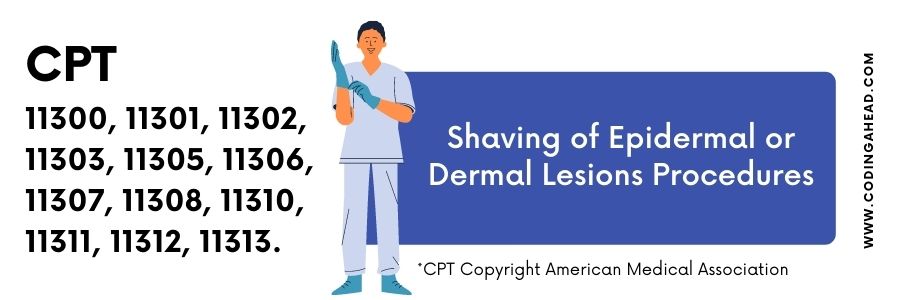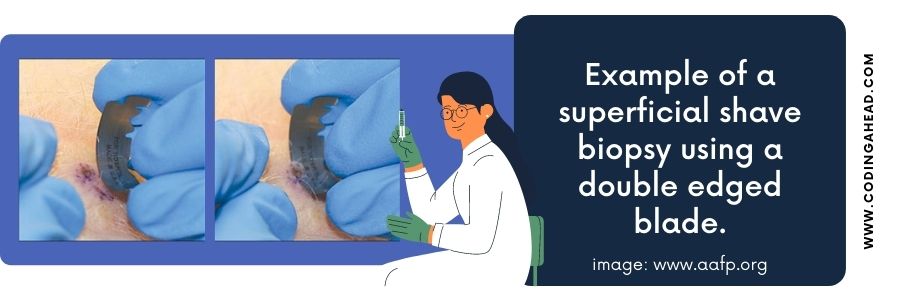Shave Biopsy CPT Codes (2023) | Descriptions, Guidelines, Reimbursement, Modifiers & Examples
Shave biopsy CPT codes 11300 – 11313 are used to code the removal of an epidermal or dermal lesion using a sharp tool rather than a full-thickness excision. When the lesion is symptomatic, such as rubbing on a waistband or bra line, they are helpful for therapeutic removal.
One can determine CPT codes for shave biopsy by the size and location of the lesion. Simple closure, if required, is included in the procedure and is not billable separately. However, documentation also consists of the position and size of each lesion.
Shave Biopsy CPT Description
CPT 11300 describes as shaving a dermal or epidermal lesion. It is for a single lesion located on the trunk, arms, or legs — a lesion diameter maybe 0.5 cm or less.
CPT 11301 describes shaving a dermal or epidermal lesion. It is for a single lesion located on the trunk, arms, or legs — a lesion diameter maybe 0.6 cm to 1.0 cm.
CPT 11302 describes shaving a dermal or epidermal lesion. It is for a single lesion located on the trunk, arms, or legs — a lesion diameter maybe 1.1 cm to 2.0 cm.
CPT 11303 narrates the shaving of an epidermal or dermal lesion for a single lesion on the trunk, arms, or legs. (Lesion diameter over 2.0 cm).
CPT 11305 narrates the shaving of an epidermal or dermal lesion for a single lesion on the scalp, neck, hands, feet, or genitalia. (Diameter of the lesion is 0.5 cm or less).
CPT 11306 narrates the shaving of an epidermal or dermal lesion for a single lesion on the scalp, neck, hands, feet, or genitalia. (Lesion diameter of 0.6 cm to 1.0 cm).
CPT 11307 narrates the shaving of an epidermal or dermal lesion for a single lesion on the scalp, neck, hands, feet, or genitalia. (Lesion diameter 1.1 cm to 2.0 cm).
CPT 11308 narrates the shaving of an epidermal or dermal lesion for a single lesion on the scalp, neck, hands, feet, or genitalia. (Lesion diameter over 2.0 cm).
CPT 11310 narrates the shaving of an epidermal or dermal lesion for a single lesion on the face, ears, eyelids, nose, lips, and mucous membrane. (Diameter of the lesion is 0.5 cm or less).
CPT 11311 narrates the shaving of an epidermal or dermal lesion for a single lesion on the face, ears, eyelids, mucous membrane, nose, and lips. (Lesion diameter 0.6 cm to 1.0 cm).
CPT 11312 narrates the shaving of an epidermal or dermal lesion for a single lesion on the face, ears, eyelids, mucous membrane, nose, and lips. (Lesion diameter 1.1 cm to 2.0 cm).
CPT 11313 narrates the shaving of an epidermal or dermal lesion for a single lesion on the face, ears, eyelids, nose, lips, and mucous membrane. (Lesion diameter of over 2.0 cm).

Shave Biopsy CPT Guidelines & Reimbursement
CPT codes 11300 – 11313 involve the removal of tangential skin lesions to a depth of no more than the dermal base. Other than the definition of biopsy, the CPT description gives no further guidelines about the difference between codes for shave removal and biopsy when a physician submits a specimen for histopathologic evaluation.
For example, the procedure should be categorized as a biopsy if the tissue is removed only to establish a diagnosis. On the other hand, shave removal suggests the intention to eliminate a lesion that already has a presumed clinical or histologic diagnosis or is being removed for a reason other than diagnosis (e.g., symptomatic relief).
On the other hand, shave removals are distinct from excisions (CPT code 11400 to CPT 11646), which must penetrate the dermis to the subcutis. Furthermore, margins are included in skin lesion excisions since an excision treatment aims to remove the whole lesion and a margin of normal skin surrounding it.
Shaving (CPT 11300 – CPT 11313) eliminates the entire lesion without penetrating the fat. (Moles are the most commonly shaven lesions).
There are codes for shaving lesions (CPT 11300 – CPT 11313) and biopsies of lesions (CPT 11100 – CPT 11101), but no codes for shaving biopsies of lesions. Therefore, the physician must properly document if he is doing a shave or a biopsy.
There are two distinct portions of CPT for these procedures. First, the physician must address the clinical documentation. Some shave removal codes are less valuable (reimbursed less) than a biopsy. If a payor examines the record with confusing vocabulary, they may pay for the lower-valued operation.
CPT 11300 – CPT 11303: These services include local anesthesia. These services include chemical or electrical wound cauterization. Use CPT 11400 – CPT 11406 for the removal of a benign lesion. Use CPT 11600 – CPT 11606 for the removal of a cancerous tumor.
Report CPT 99000 for handling or transportation if related staff transports the specimen to an outside laboratory. When the physician provides these treatments in an emergency department, it is inappropriate to report supplies.
The coder can document the ‘supplies’ for physician offices using the appropriate HCPCS Level II code. Then, to determine coverage, contact the specific payer.
CPT 11305 — CPT 11308: The physician removes a single, enlarged epidermal or dermal lesion from the head, neck, hands, feet, or genitalia by shave excision. Underneath the lesion, the physician administers local anesthesia.
Then, he positions the scalpel blade against the skin close to the lesion. The physician excises the lesion from its base using a horizontal slicing motion. He does not require suturing and controls the bleeding using chemical or electrical cauterization.
Use CPT 11305 for lesions with a diameter of 0.5 cm or less. Use CPT 11306 for lesions with a diameter of 0.6 cm to 1 cm, CPT 11307 for lesions with a diameter of 1.1 cm to 2 cm, and CPT 11308 for lesions larger than 2 cm.
If the physician indicates the additional time and effort, append modifier 22 and provide a cover letter and an operative report. These codes cover the chemical or electrocauterization of the wound. For example, use CPT 11420 – CPT 11426 to remove a benign lesion.
On the other hand, use CPT 11620 – CPT 11626 to remove a cancerous tumor. Surgical trays, A4550, are not independently paid by Medicare; other third-party payers may cover them. To determine coverage, contact the specific payer.
CPT 11310 — CPT 11313: The physician extracts a single, raised epidermal or dermal lesion from the face, ears, eyelids, lips, nose, or mucous membrane by shave excision. Underneath the lesion, the physician administers local anesthesia.
Next, he places a scalpel blade against the skin close to the lesion. Finally, the physician excises the lesion from its base using a horizontal slicing motion.
It does not require suturing, and the physician controls the bleeding using chemical or electrical cauterization — Report CPT 11310 for lesions with a diameter of 0.5 cm or less.
CPT 11311 for lesions with a diameter of 0.6 cm to 1 cm. CPT 11312 for lesions with a diameter of 1.1 cm to 2 cm, and 11313 for lesions larger than 2 cm. This treatment includes a local anesthetic.
Report 99000 for handling and transportation if a related attendant delivers a tissue to an outside laboratory. Use 17000 to eliminate a premalignant lesion using electrosurgical destruction, cryosurgical destruction, or other procedures.
These surgeries involve the wound’s local anesthesia and cauterization (chemical or electro). Use CPT 11440 – CPT 11446 to remove a benign lesion. To remove a cancerous tumor, use CPT 11640 – CPT 11646. Report CPT 99000 for handling or transportation if some affiliated individual delivers a tissue to an external laboratory.
Shave Biopsy CPT Modifiers
The following are common modifiers used:
Use modifier 22 when the biopsy takes longer than regular procedural services.
Use modifier 51 when the physician performs multiple biopsies at a time.
Use modifier 52 when the physician performs a partially reduced procedure.
Use modifier 53 when the physician stops a surgical or diagnostic procedure after it has begun due to unforeseen circumstances.
Use modifier 58 when the physician performs a biopsy during a global period. It may be staged or related to surgery or service performed by the same provider or another health care provider during the postoperative period.
Use modifier 59 when the physician performs dissimilar procedural services other than E/M.
Use modifier 78 when a patient has an unplanned return to the operating room by the same provider or another healthcare professional following an initial procedure for a related surgery during the postoperative period.
Use modifier 79 when a physician performs an unrelated procedure or service provided by the same provider or other qualified health care provider during the postoperative period.
Billing Examples
The following are examples of when shave biopsy CPT codes may be used.

Example 1
A woman presented herself with a verrucous lesion on the philtrum of her face. The physician executed the shave biopsy procedure and noted the incision size of 4 mm. The entire lesion was excised and submitted to pathology for analysis.
The coder must use CPT 11310 as it is more relevant because shaving the lesion on the face was done, and the lesion diameter was 0.4 cm.
Example 2
A male patient reported having recurring seborrheic keratosis of the left cheek. The physician indicated the region and shaved.
The area was treated and draped hygienically after being injected with local anesthesia. Next, the physician shaved a 1.8 cm lesion with an 11-blade razor and used light pressure to produce precise hemostasis.
The staff member transported the material to the pathology lab for the final analysis. Again, the patient well tolerated the operation.
The location of this lesion on the left cheek restricts the range to CPT 11310 – CPT 11313 because the physician shaved the size of the 1.8 cm lesion, so CPT 11308 is a more relevant code to bill.
Example 3
The male patient comes to the provider’s office with a dilemma. The provider reviewed and reported three lesions: one on the side of the eye, the other under the eye, and the third lesion on the forehead.
The lesions near the eye are both 0.5 cm and were described simply as “skin lesions rule-out basal cell cancer,” The lesion on the forehead was 1 cm and described as “Actinic Keratosis” (per the notes, the sizes included the margin). The method used to remove these lesions was shaving.
The coder may select appropriate codes as CPT 11311 and CPT 11310 (2 units), with modifier 59.



